#poem coates kinney
Explore tagged Tumblr posts
Text

Rain on the Roof
When the humid showers gather over all the starry spheres, And the melancholy darkness gently weeps in rainy tears, 'Tis a joy to press the pillow of a cottage chamber bed, And listen to the patter of the soft rain overhead.
Every tinkle on the shingles has an echo in the heart, And a thousand dreamy fancies into busy being start; And a thousand recollections weave their bright hues into woof, As I listen to the patter of the soft rain on the roof. by Coates Kinney
65 notes
·
View notes
Text
For Poetry Month, We Salute 18 Renowned Cincinnati Poets From Days Gone By
Each April, the Academy of American Poets sponsors National Poetry Month. In recognition of Cincinnati’s extensive contributions to that genre, here is a collection of local poets who achieved distinction. If living poets were included, this list could easily triple in length.
A Careless Poet Soon Forgotten Among the earliest poets writing in Cincinnati was Charles A. Jones (1815-1851). He built a career publishing verse narratives about the Indians and outlaws of the western country. Between the years 1836 and 1839 he wrote frequently for the Cincinnati Mirror, and in 1840 contributed several poems to the Cincinnati Message, but paltry payments for these efforts led him to take up the law as his main career. A critic, William Turner Coggeshall, writing in 1860, admired Jones’ imagination and energy, but deplored his slapdash compositional habits and his aversion to revision: “The hasty production of an hour was sent to the press with all its sins upon its head.”

His Poem No Longer Memorized, Even The Plaque Is Gone Generations of American schoolchildren were compelled to read and memorize a Civil War poem by Thomas Buchanan Read (1822-1872) titled “Sheridan’s Ride.” The poem celebrated General Philip Sheridan’s rallying his soldiers to victory at the 1864 Battle of Cedar Creek in Virginia. It was so popular that newspapers often parodied it to skewer other topics. For many years, a plaque was mounted on the wall opposite the Public Library on Eighth Street commemorating the address at which Read wrote the famous poem. Read was popular and prolific; his poetry was collected in 1867 in a set of three volumes. In addition to poetry, Read was an accomplished painter. Several of his works, notably “The Harp of Erin” are displayed at the Cincinnati Art Museum.
Lawyer By Trade, Hero By Aspiration Although William Haines Lytle (1826-1863) studied law, he preferred the life of a soldier and composed poetry to celebrate his own heroic exploits. Lytle came from an honored line of military heroes. He fought in the Mexican War as a captain and achieved the rank of brigadier general during the Civil War. His verses were popular on both sides of the Mason-Dixon line. When a sniper’s bullet found him at Chickamauga in 1863, the rebel soldiers recognized Lytle and posted a guard around his body until it could be sent back to Cincinnati. As they stood watch, the Confederates quietly recited Lytle’s poems. Lytle Park in Cincinnati was his family’s estate.

An Inveterate Revisionist Coates Kinney (1826-1904) was not a Cincinnati native, but he relocated to the Queen City at an early age. Kinney served in the Union Army during the Civil War and in the Ohio General Assembly afterwards while also practicing law and working as a journalist. He was just 23 when he wrote his most famous poem, “Rain on the Roof,” which was reprinted, collected, set to music, pirated, misattributed and celebrated throughout his life. Much of the confusion derived from Kinney’s incessant tinkering with the poem. Over his lifetime, he declared at least three different versions to be definitive.
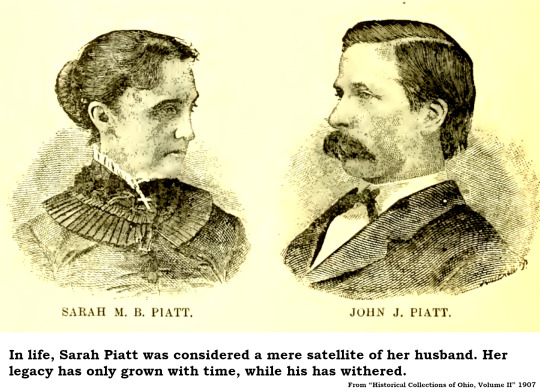
The Piatts Helped Save Harrison’s Tomb Sarah Morgan Bryan Piatt (1836-1919) and John James Piatt (1835-1917) were Cincinnati’s answer to England’s Brownings (Robert and Elizabeth Barrett). A married couple, each earned a reputation as a poet. James Piatt was a scion of the wealthy Piatt family, though he never had much money himself. Sarah, known as Sallie, was related to orator and politician William Jennings Bryan. The couple, who lived just outside North Bend when they weren’t posted to one of John’s political appointments in Washington or Ireland, worked to preserve the tomb of William Henry Harrison. In life, John’s reputation eclipsed his wife’s. In recent years, new critical appraisals agree that Sarah was, by far, the better and more innovative poet.
Newspapers Led Everard Appleton To Poetry Everard Jack Appleton (1872-1931) started out as a newspaperman, with stints at Cincinnati’s Tribune, Commercial Gazette and Times-Star, earning a slot as a columnist known for humorous items in verse and prose. He also contributed stories and poems to national publications. He left behind a half-dozen volumes of poetry of which the best-known is probably “The Quiet Courage.” Appleton lived on Forest Avenue in Avondale.
A National Reputation Based On Odes To Domesticity Bertye Young Williams (1877-1951) published as B.Y. Williams over a productive career that resulted in a half-dozen books of poetry and appearances in the New York Times, Ladies Home Journal, Good Housekeeping, Saturday Evening Post and other nationally distributed magazines. She founded a poetry magazine and publishing house, Talaria, with fellow poet Annette Patton Cornell. She was president of the Ohio Chapter of the League of American Pen Women and of the Cincinnati Women’s Press Club. A book she co-authored with Annette Patton Cornell, “Garland for a City,” was illustrated by Caroline Williams (no relation).
Cincinnati’s Unsung (But Prolific!) Poet, Horace Williamson Horace G. Williamson (1880-1943) was perhaps the most prolific poet in Cincinnati history. You won’t find him in English class these days, nor in any anthologies. Williamson wrote for money, not for art. In the early 1900s, Williamson built a profitable sideline writing poems for greeting card companies, sometimes ghost-writing love letters on spec. He had a lot of side hustles. While employed as social secretary of the YMCA, Williamson ran a talent agency and also performed in character as the Roman dictator Cincinnatus in quite a few civic celebrations.
Confined To Bed, Raymond Dandridge’s Spirit Soared Although he once achieved fame, Raymond Garfield Dandridge (1883-1930) is sadly forgotten today. His poetry fits comfortably between his predecessor Paul Laurence Dunbar (to whom Dandridge was often compared) and his successor, Langston Hughes, beacon of the Harlem Renaissance. Dandridge was almost totally paralyzed by polio when he was a young man. He spent his entire writing career confined to bed, supporting himself and his mother by taking orders for coal shipments. Eventually, Dandridge’s poetry was collected by his friends into three slim volumes, offered for sale to augment his income as a coal merchant.
George Elliston’s Poetic Legacy Lives On Eccentricity manifested itself in the person of George Elliston (1883-1946). She was a longtime Cincinnati newspaperwoman who lived like a derelict but cultivated a bohemian entourage. At her death, Elliston left behind a few slim volumes and an estate worth a quarter-million dollars, grubbed together over the years by living in cold-water apartments, wearing castoff clothing and mooching meals. She bequeathed all of this to the University of Cincinnati to establish a modern poetry collection. Some of the great poets of the English language, such as Denise Levertov and Robert Frost, have served as Elliston poets-in-residence.
Eloise Robinson Was A Rare Woman War Poet Few Cincinnatians knew that Mrs. Corda Muchmore, wife of a College Hill realtor, was, in fact, Eloise Robinson (1888-1958), one of the finest war poets of America. In 1918, she journeyed to France with the YMCA to hand out refreshments and recite poetry to support the American troops. Her poems inspired by her days at the front, such as “He Had Such Glory In His Closing Eyes” and “War” were published nationally and much admired. She taught verse writing to generations of Cincinnatians through UC’s Evening College.
Postmaster And Poet Samuel Schierloh (1889-1968) followed a colorful road to poetry. Born in Reading, Ohio, he served five years in the Navy during the days when it was known as Teddy Roosevelt’s “Great White Fleet.” After a few years as an apprentice tailor in downtown Cincinnati, he joined the Post Office and eventually became postmaster in Mount Washington. In addition to penning poetry, he was a league bowler, golfer and an amateur painter. His poems mostly debuted in Cincinnati newspapers, but were collected in several volumes including “Down the Bright Seas” in 1958.
Cornell Declined Appointment As Ohio’s Poet Laureate In 1974, Annette Patton Cornell (1897-1986) was named the best Cincinnati writer of the past 50 years by the National Society of American Pen Women. Over a long career, she published five collections of her own poetry and promoted the work of others through a literary magazine, Talaria, she founded with fellow Cincinnati poet B.Y. Williams. Cornell had her own radio show devoted to poetry and other literary topics. An Ohio governor tried to recruit her as the state’s poet laureate, but she declined the invitation as a resident of Fort Mitchell, Kentucky. Her son, Si Cornell, had a long career at the Cincinnati Post.
Lawrence Welk Boosted The Career of Cincinnati’s Greeting Card Poet All of Helen Steiner Rice’s (1900-1981) best-selling books were published by Cincinnati’s Gibson Greeting Card Company. Rice was born in Lorain, Ohio and married a Dayton banker who committed suicide during the Great Depression. After working in publicity and inspirational speaking, she joined Gibson as an editor and worked there for more than 40 years. Her book sales skyrocketed in the 1960s when several of her poems were read on the Lawrence Welk television show.
X-ray Damage Launched A Poet’s Career While still a teenager, Anna M. Tansey (1906-1989) almost died when a doctor exposed her to a nearly fatal dose of X-rays. She lost one lung and part of another. Long an invalid, confined to bed, she devoured piles of books brought by her family from the library. When new antibiotics allowed her to leave her house, she embarked on a career as a poet and an advocate for ecumenical relations among religions. Her poems were often on spiritual themes, as the title of her best-selling poetry collection, “Seven Gifts of the Holy Spirit” illustrates. As arthritis claimed her ability to type, she composed on a dictating machine and had her poems typed out by an assistant.
A Poet Of Great Influence Kenneth Koch (1925-2002) was born in Cincinnati to a fairly well-to-do family. His father sold office furniture and the family had a live-in maid. The family was frequently mentioned in Cincinnati newspaper society columns. After military service during World War II, Koch earned his doctorate and began a long career at Columbia University. Although he published dozens of books and was frequently anthologized, Koch is often remembered more today as a teacher than as a poet. His book on teaching children to write poetry, “Wishes, Lies and Dreams” (1970) was enormously influential.
One Small Poem For A Man . . . The oeuvre of Neil Armstrong (1930-2012), poet, is slight, consisting as it does of only two published stanzas, and that bit of doggerel clouded by controversy. In 1978, the Mini Page, a nationally syndicated children’s section carried in many newspapers, including the Cincinnati Post, asked Armstrong to provide a quote or first-person account of his moon landing. Rather than jotting a few lines of prose, Armstrong, then a professor at the University of Cincinnati, penned eight lines of poetry, clearly aimed at a juvenile audience. Unfortunately, through an editing error, the Mini Page deleted two words from Armstrong’s final line. Armstrong was not happy.
7 notes
·
View notes
Text
April 17, 2020
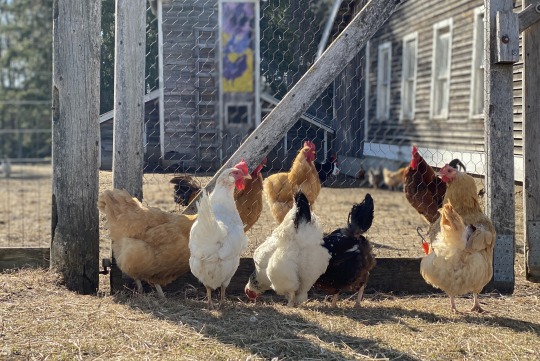
Photo: Chickens in the barnyard.
At North Country School the belief that nature is our master teacher is woven into all that we do. It is the thread that connects us to the majestic wild spaces that surround our 220-acre campus, to the seeds we sow each spring that become our food, and to the barnyard creatures that we care for together on our farm. The children who attend North Country School and Camp Treetops form a deep understanding of the life cycles of our natural world, and the lessons learned through that understanding are carried with them their entire lives. Observing the cycles of the natural world—the changing of the seasons, the sprouting of a seed, the growth of a seedling, the laying and hatching of an egg—can bring calm, appreciation, and reflection to our current lives where those peaceful moments may be in shorter supply. During a time when much of our community is scattered around the globe, we take solace in the fact that our current and past students and campers bring that connection to nature with them. We hope that, wherever you are, you can take a moment with your loved ones to observe and enjoy the outdoors. Know that we on the North Country School campus will be doing the same.
Please keep sending us your photos, and we will add them to our NCS at Home: Spring 2020 photo library. Email photos to [email protected].
Note: Our campus is closed to all students for the remainder of the school year, with the exception of the international students who remained here during spring break, rather than returning to their home countries during the early stages of the outbreak. These 18 students, along with our houseparents and faculty, are staying on campus and enjoying outdoor adventures in the contiguous wilderness during this time. They have been and will continue to take appropriate safety and prevention measures.
CREATIVITY AND CONNECTION

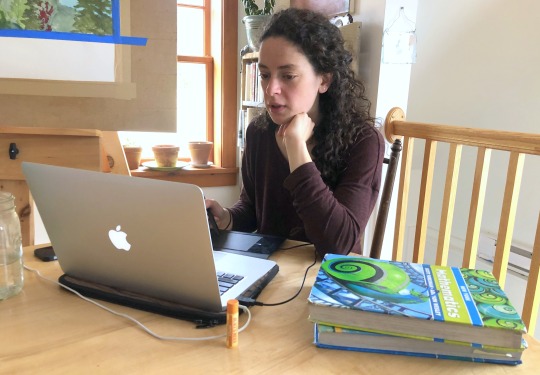

Top: Jack teaches 6th-grade English class. Middle: Gavi teaches 4th- and 5th-grade math class. Bottom: Gavi’s math lesson.
This week our teachers, like so many educators around the globe, continued to think of new and creative ways to engage with students. 6th-grade humanities teacher Jack introduced his class to a fun vocabulary game using the educational website Quizzizz, while 4th- and 5th-grade math teacher Gavi taught her class a fractions lesson using a tablet as a whiteboard, which allowed her to work through equations alongside the class in real-time.
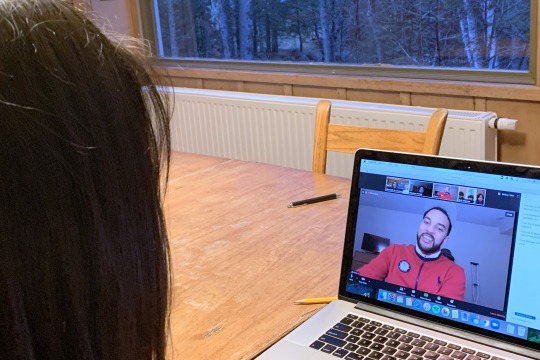


Top: Cocona meets an Olympian on Zoom. Middle: 9th-grade English class poem. Bottom: Meredith teaches 9th-grade English class.
Japanese teacher Meredith and school nurse Shannon worked together this week to connect a US Olympian to several of our on-campus students. Four of our Japanese students, along with several other on-campus students, had the opportunity to talk over Zoom with Chris Kinney—a bobsledder on the US Olympic team whose grandmother is Japanese and who has worked in Japan. Chris competed in the 2018 PyeongChang Olympics and will be competing in Beijing in 2022. The students were able to ask Chris questions in both Japanese and English, and learned about what life looks like for an Olympic athlete.
Meredith’s 9th-grade English class has been studying poetry over the past two weeks, examining the different ways writers throughout history have used poetic writing to translate the human experience, and applying that concept to the challenges of our own time. This past week, the class read the poem “To Prisoners” by Gwendolyn Brooks, and watched a video of other writers and former prisoners discussing the work and its impact on their own lives. The class has also been working on their own poems about their experiences in nature. Below, find an excerpt from 9th-grader David’s untitled villanelle poem:
Then, I thought in the dark
I pictured myself, under an ice shelf, just by myself
I think, I reflect, I want to restart
Can't see trails, but I followed my heart
The light, it shines, in myself,
I came, I saw, I came, I saw the art
I think, I reflect, I want to restart
A PLACE TO PLAY

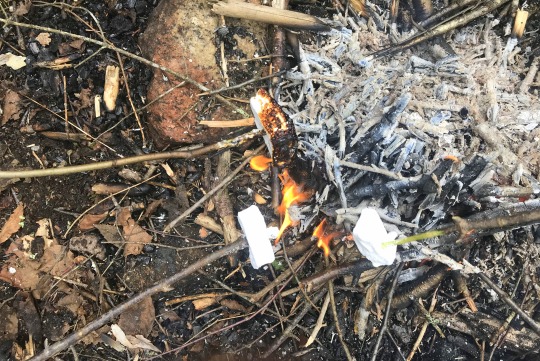

Top: Rebecca roasts a marshmallow. Middle: Roasting marshmallows. Bottom: Nurse Jess and her son, Wyatt, in a running race.
While life on the NCS campus may look different in many ways, students and adults are still getting in plenty of outdoor playtime. This past week, the students living in Cascade House made homemade marshmallows, and then roasted those marshmallows over a campfire by one of our lean-tos. Nurse Jess and her son, Wyatt, also took the time for a fun outside activity, participating in a “race around your house 5k” at the suggestion of Wyatt’s local elementary school.
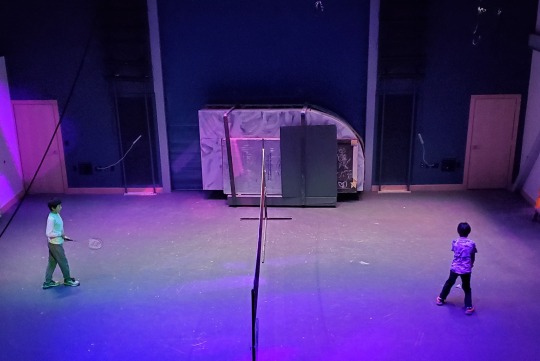

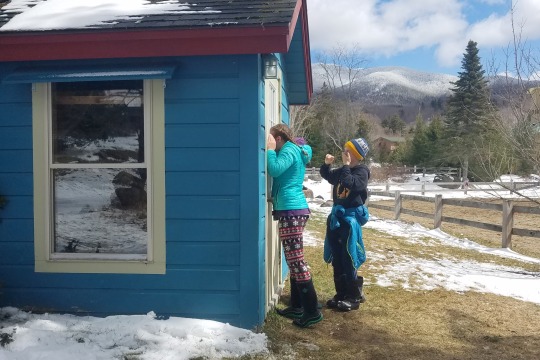
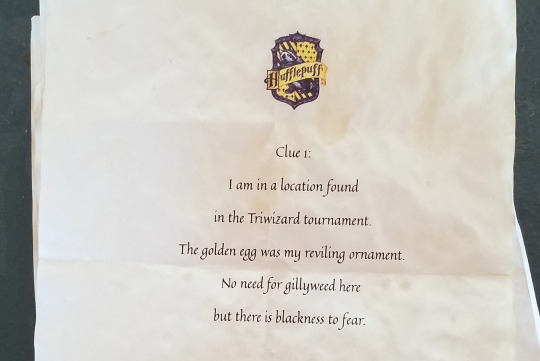
Top: Badminton with stage lighting. Middle 1: Participating in the Saturday Night Activity from home. Photo Credit- Jane Mellow. Middle 2: Student Ella and her brother, Pete, participate in Harry Potter LARPing. Bottom: A clue from the Harry Potter LARPing activity.
Our students and adults put their creative spin on play this week, adding fun and surprising elements to more traditional activities. During out-time this week, the students living in Mountain House played badminton under colorful stage lighting in The Walter Breeman Performing Arts Center, which added an extra layer of drama to the competition. This week’s Saturday Night Activity brought our on- and off-campus community together to participate in a bridge-building competition using unconventional materials. Students, teachers, and alumni used spaghetti, string, tape, and a marshmallow to build their structures, with the students of Cascade House declared the ultimate winners of the competition. Our on-campus community also spent this past Saturday participating in a Harry Potter live action role playing quest organized by teachers Courtney and Melissa and farm intern Bri. Students and teachers were divided into Hogwarts Houses and given clues to locate and decipher at various spots around campus. Students traveled around our campus trails, exploring outbuildings and participating in battles in order to complete their magical adventure.
NCS AT HOME


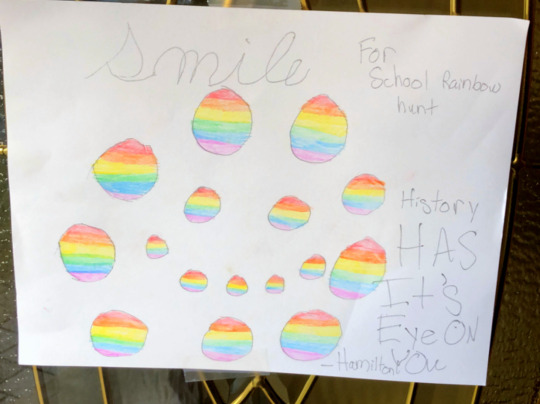
Top: 9th-grader Bladen hikes Hurricane Mountain. Middle: 7th-grader Olivia does work from home. Bottom: Olivia participates in the NCS rainbow hunt activity.
Though the majority of our students are in their respective homes around the globe, we have been thrilled to see that they are still engaging in NCS skills and interests with their families. We have loved hearing from our long-distance community members as they explore the outdoors, cook, and engage in creative work. This week we received updates from 9th-grade day student Bladen, who hiked to the summit of nearby Hurricane Mountain with his mother, and from 7th-grader Olivia, who did some schoolwork beside a pond and participated in the NCS Find a Rainbow Challenge with her family.
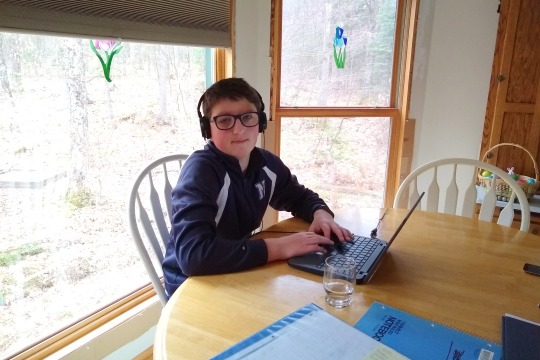

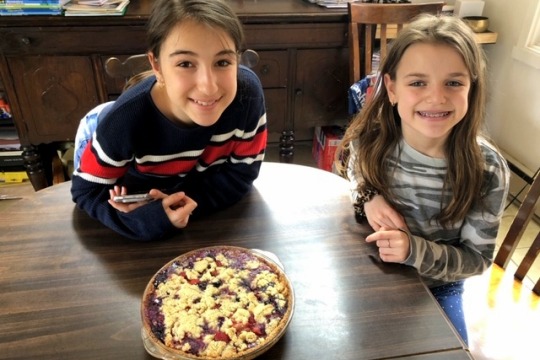
Top: 7th-grader JT completes school work from home. Middle: 7th-grader Colton bakes the “What’s Cooking?” blueberry muffin recipe. Bottom: Sisters Dominica and Kalina bake a berry pie.
This week we also received updates from 7th-grader JT, who has been participating in his online classes from his local home as well as making progress on his fiber arts knitting projects. 7th-grader Colton and sisters Dominica and Kalina have been practicing their Edible Schoolyard skills with their families, with Colton baking the blueberry muffins featured on the “What’s Cooking at NCS/CTT” blog, and Dominica and Kalina cooking up a pot of egg drop soup and baking a colorful berry pie.
FARM AND GARDEN
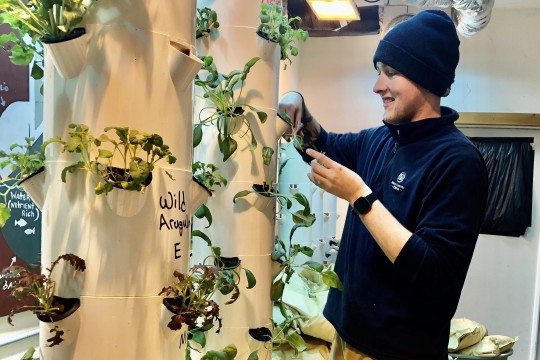

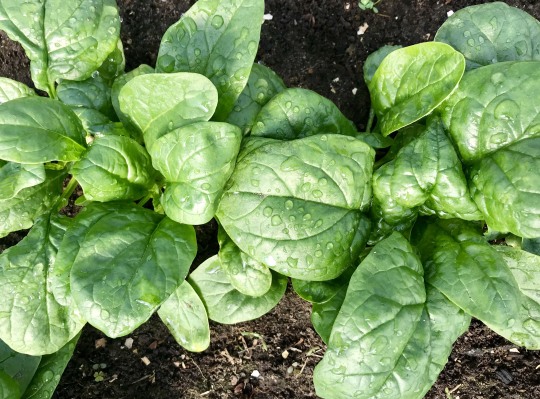
Top: Farm intern Nick harvests greens from the aeroponics room. Middle: Garlic sprouting in the field. Bottom: Spinach in the greenhouse.
Our barns and growing spaces have been busy with activity this week, with new green growth in the fields and the exciting start to harvesting in our aeroponics room. Farm interns Nick and Bri cut the first arugula, spinach, and mizuna greens from our aeroponic towers this week, and the delicious greens—which are grown without soil—were enjoyed in meals prepared by our kitchen staff.
Out in the fields, we saw the first bright green garlic shoots pushing through their mulched beds. The garlic was planted last fall by our 7th-grade Edible Schoolyard students, and welcoming the resilient crop after many months covered by snow and ice was an optimistic sign of good things on the horizon, as well as a warm reminder of the many hands that made light work of planting that crop. In the greenhouses we continued to harvest vibrant spinach greens, and look forward to the upcoming weeks when a bounty of herbs, greens, vegetables, and flowers will be filling the greenhouses and outdoor garden beds.



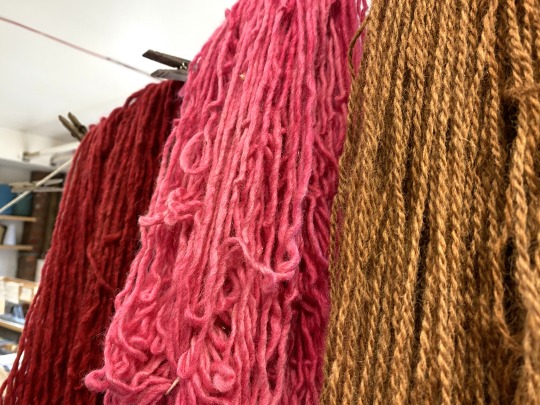
Top: Noni cares for the horses. Middle 1: Goats in the horse barn. Middle 2: Undyed spun wool. Bottom: Dyed wool hanging in the fiber arts studio.
Down at the barn, art teachers Noni and Katie have been helping Barn Manager Erica care for our many creatures, prepare our ewes for the upcoming lambing season, and ready our wool for use. Noni spent some time in the pasture with our horses, lending a hand with some necessary grooming as the herd sheds their thick winter coats. Meanwhile, our goats paid a social call to the horse barn, enjoying a snack of hay in the foyer. Erica and Noni also worked on skirting, or cleaning, our wool fleeces this week, as well as preparing our spun yarn for use in the fiber arts program. The spun scanes of yarn were brought to the art studio for dyeing and drying, and will soon be ready to be turned into students’ and campers’ future weaving and knitting projects.
We hope that you and your loved ones are staying safe and healthy, and that your communities are caring for and supporting one another. We will continue to update you about our community throughout this time, and encourage you all to reach out to us as well.
CONNECTING WITH OUR COMMUNITY:
Mondays: Check our Facebook page every Monday for a video from our School Counselor, Lauren, on tips for getting through this challenging time.
Tuesdays: Creature Query- Barn Manager Erica Burns will be answering questions about the animals on our farm using fun and educational videos. This week Erica taught us how to prepare our sheep’s wool for spinning. Check it out on our Facebook page.
Wednesdays: What’s Cooking at NCS and Camp Treetops?- Edible Schoolyard instructor Elie Rabinowitz, along with other community members, will provide simple recipes and cooking resources you can use to prepare delicious meals at home with your families. This week Garden Manager Tess will share a garden-fresh spinach and feta frittata recipe, and next week Head of Kitchen Paulette will show us how to make sticky buns. Check out all of the recipes on Facebook and on Tumblr.
Thursdays: Birding with Jack- 6th-grade English teacher Jack Kiernan will offer the NCS community an opportunity to connect through the world of birds by providing the resources to become familiar with birds that our community is seeing around the globe. If you are out for a walk or sitting at home, looking out the window, take a moment to log the birds you see with the NCS eBird account. Jack will provide videos and information about birds being logged, as well as birds he is seeing on his daily birding adventures! Check it out on our Facebook page and on Tumblr.
Fridays: Check our Facebook page every Friday for a video featuring a Japanese mini-lesson by teacher Meredith Hanson. This week Meredith talked about forest bathing, a Japanese practice of calmly being in nature.
Saturdays: The NCS Saturday Night Activity- Every Saturday at 8 p.m., NCS teacher Larry Robjent, along with other NCS faculty, will be hosting fun activities similar to those typically held on campus with students. Participate live from home with your own families. Last week, Larry and English teacher Melissa Orzechowski built bridges using 20 sticks of spaghetti, one yard of string, one yard of tape, and one marshmallow. This week, Larry and a guest host will run a reverse auction.
For more information about the #ThisWeekAtNCS blog, contact Becca Miller at [email protected].
For general school information, call 518-523-9329 or visit our website: www.northcountryschool.org
0 notes
Text
Rain On The Roof Summary Class 9 English
Rain On The Roof Summary Class 9 English
Rain On The Roof Summary In English
About the Poet Coates Kinney (November 24, 1826 — January 25,1904) was a lawyer, politician, journalist, and poet from the U.S. Kinney caught an inspiration one night while trying to woo sleep in the old college dormitory, and there put on paper this beautiful bit of verse, ‘The Rain on the Roof’. This poem made Kinney famous. He began travelling and is on the…
View On WordPress
0 notes
Text
Rain On The Roof Summary Class 9 English
Rain On The Roof Summary Class 9 English
Rain On The Roof Summary In English
About the Poet Coates Kinney (November 24, 1826 — January 25,1904) was a lawyer, politician, journalist, and poet from the U.S. Kinney caught an inspiration one night while trying to woo sleep in the old college dormitory, and there put on paper this beautiful bit of verse, ‘The Rain on the Roof’. This poem made Kinney famous. He began travelling and is on the…
View On WordPress
0 notes
Text
Rain On The Roof Summary Class 9 English
Rain On The Roof Summary Class 9 English
Rain On The Roof Summary In English
About the Poet Coates Kinney (November 24, 1826 — January 25,1904) was a lawyer, politician, journalist, and poet from the U.S. Kinney caught an inspiration one night while trying to woo sleep in the old college dormitory, and there put on paper this beautiful bit of verse, ‘The Rain on the Roof’. This poem made Kinney famous. He began travelling and is on the…
View On WordPress
0 notes
Text
Rain On The Roof Summary Class 9 English
Rain On The Roof Summary Class 9 English
Rain On The Roof Summary In English
About the Poet Coates Kinney (November 24, 1826 — January 25,1904) was a lawyer, politician, journalist, and poet from the U.S. Kinney caught an inspiration one night while trying to woo sleep in the old college dormitory, and there put on paper this beautiful bit of verse, ‘The Rain on the Roof’. This poem made Kinney famous. He began travelling and is on the…
View On WordPress
0 notes
Text
Rain On The Roof Summary Class 9 English
Rain On The Roof Summary Class 9 English
Rain On The Roof Summary In English
About the Poet Coates Kinney (November 24, 1826 — January 25,1904) was a lawyer, politician, journalist, and poet from the U.S. Kinney caught an inspiration one night while trying to woo sleep in the old college dormitory, and there put on paper this beautiful bit of verse, ‘The Rain on the Roof’. This poem made Kinney famous. He began travelling and is on the…
View On WordPress
0 notes
Text
Rain On The Roof Summary Class 9 English
Rain On The Roof Summary Class 9 English
Rain On The Roof Summary In English
About the Poet Coates Kinney (November 24, 1826 — January 25,1904) was a lawyer, politician, journalist, and poet from the U.S. Kinney caught an inspiration one night while trying to woo sleep in the old college dormitory, and there put on paper this beautiful bit of verse, ‘The Rain on the Roof’. This poem made Kinney famous. He began travelling and is on the…
View On WordPress
0 notes
Text
Rain On The Roof Summary Class 9 English
Rain On The Roof Summary Class 9 English
Rain On The Roof Summary In English
About the Poet Coates Kinney (November 24, 1826 — January 25,1904) was a lawyer, politician, journalist, and poet from the U.S. Kinney caught an inspiration one night while trying to woo sleep in the old college dormitory, and there put on paper this beautiful bit of verse, ‘The Rain on the Roof’. This poem made Kinney famous. He began travelling and is on the…
View On WordPress
0 notes
Text
Rain On The Roof Summary Class 9 English
Rain On The Roof Summary Class 9 English
Rain On The Roof Summary In English
About the Poet Coates Kinney (November 24, 1826 — January 25,1904) was a lawyer, politician, journalist, and poet from the U.S. Kinney caught an inspiration one night while trying to woo sleep in the old college dormitory, and there put on paper this beautiful bit of verse, ‘The Rain on the Roof’. This poem made Kinney famous. He began travelling and is on the…
View On WordPress
0 notes
Text
Rain On The Roof Summary Class 9 English
Rain On The Roof Summary Class 9 English
Rain On The Roof Summary In English
About the Poet Coates Kinney (November 24, 1826 — January 25,1904) was a lawyer, politician, journalist, and poet from the U.S. Kinney caught an inspiration one night while trying to woo sleep in the old college dormitory, and there put on paper this beautiful bit of verse, ‘The Rain on the Roof’. This poem made Kinney famous. He began travelling and is on the…
View On WordPress
0 notes
Text
Rain On The Roof Summary Class 9 English
Rain On The Roof Summary Class 9 English
Rain On The Roof Summary In English
About the Poet Coates Kinney (November 24, 1826 — January 25,1904) was a lawyer, politician, journalist, and poet from the U.S. Kinney caught an inspiration one night while trying to woo sleep in the old college dormitory, and there put on paper this beautiful bit of verse, ‘The Rain on the Roof’. This poem made Kinney famous. He began travelling and is on the…
View On WordPress
0 notes